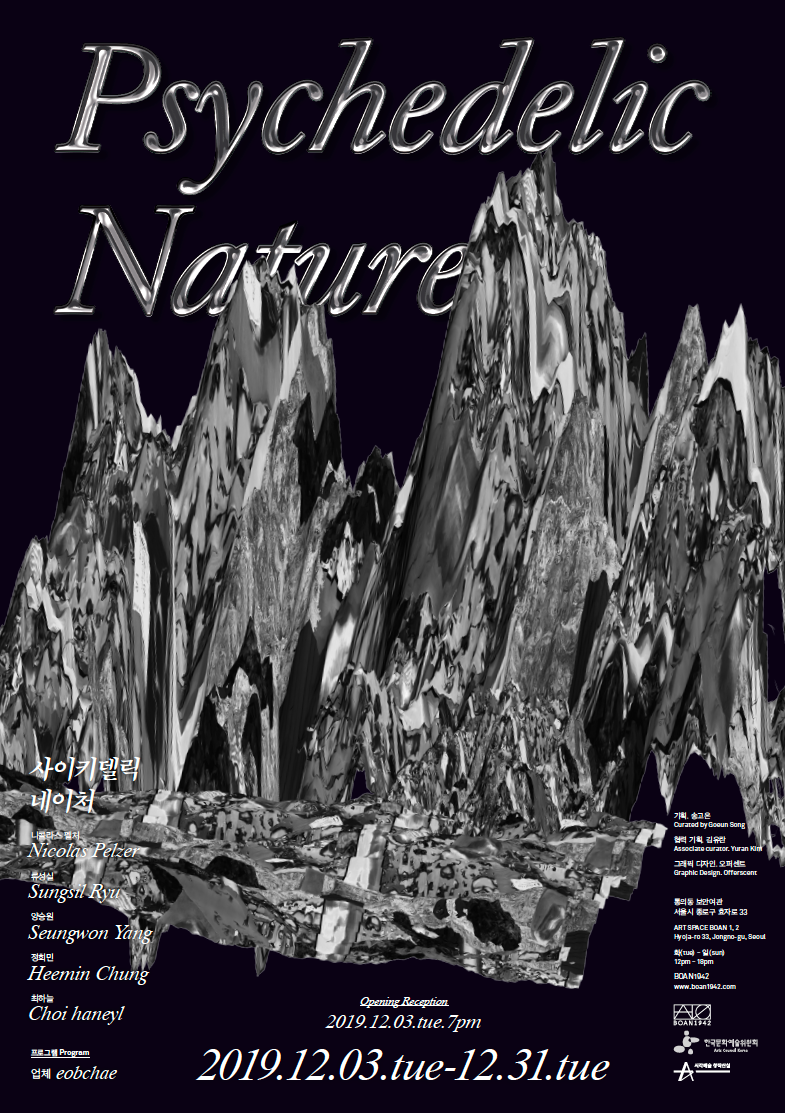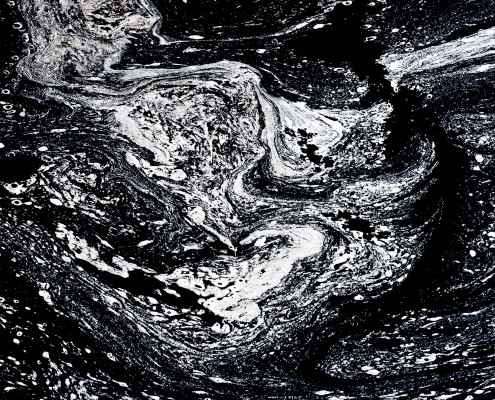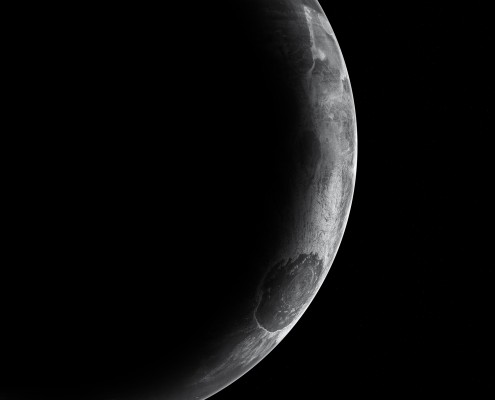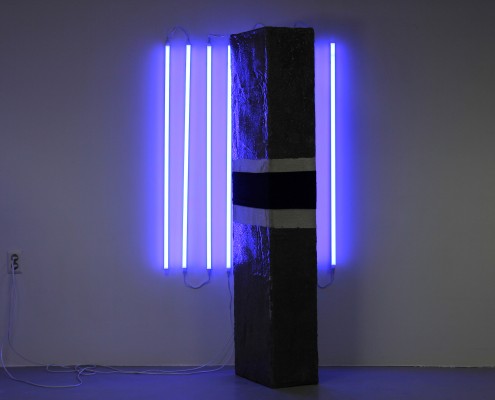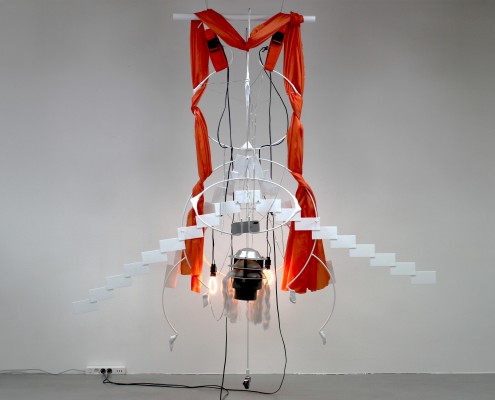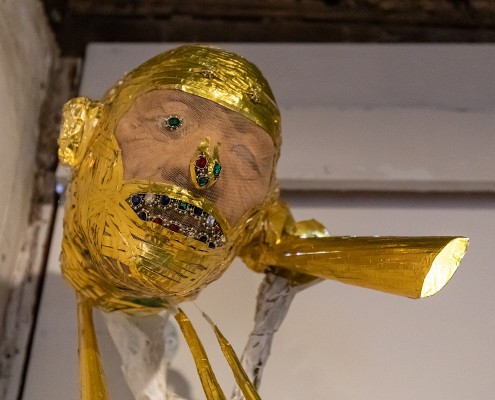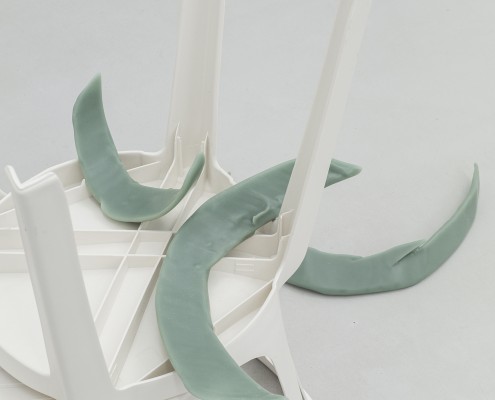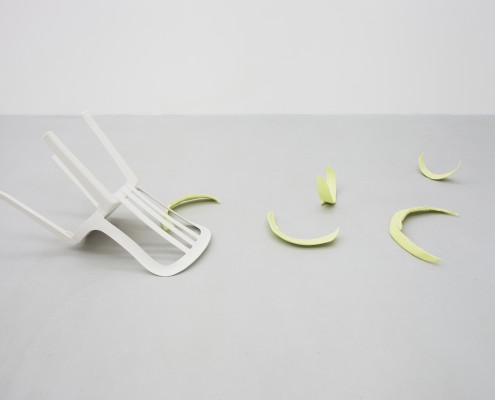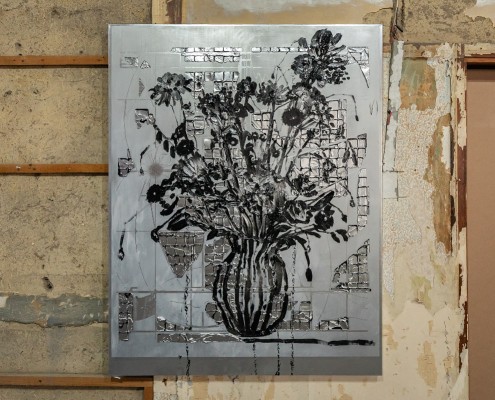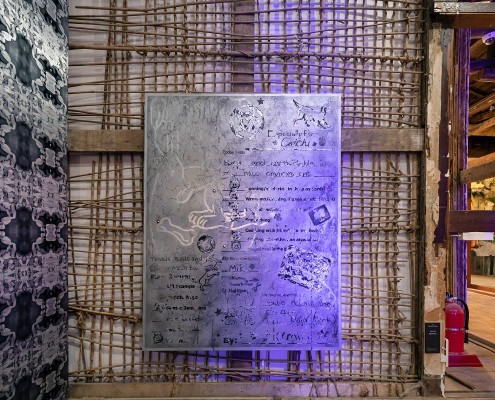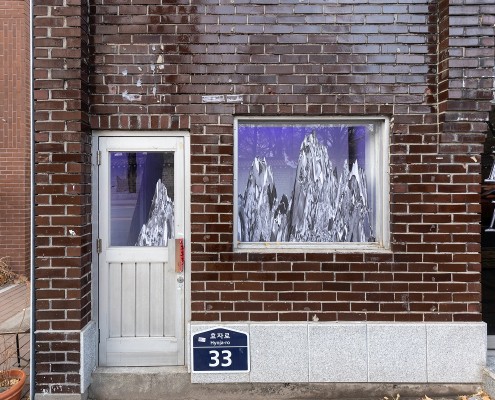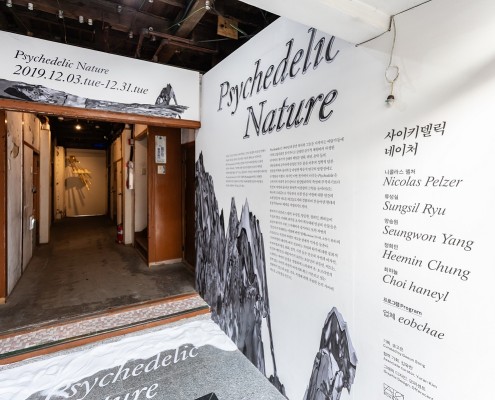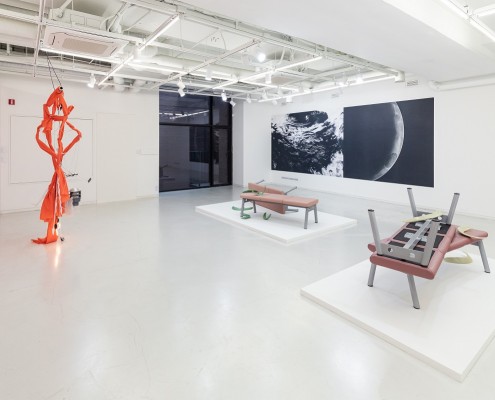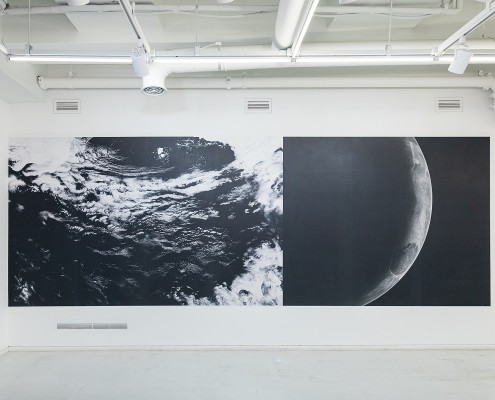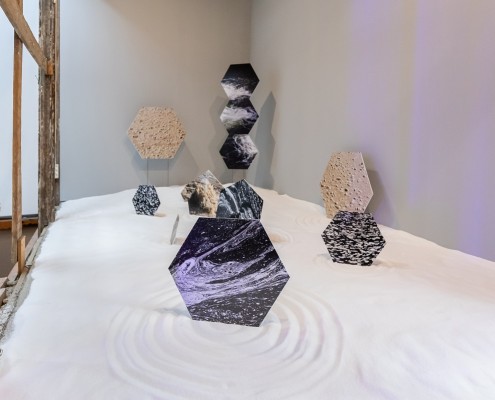자연은 늘 같은 언어로 이야기한다. 하지만 인간의 마음은 언제나 자연과 새로운 접속을 일으킨다. “자연에 대한 인간의 환영은 오늘날 세계를 어떻게 변화시켰을까?”라는 질문에서 출발한 <사이키델릭 네이처>(Psychedelic Nature)는 인공 낙원의 혼종적(hybrid) 자연를 지칭하는 Psychedelic을 다룬다. 니콜라스 펠처(Nicolas Pelzer), 류성실, 양승원, 정희민, 최하늘이 포착한 뒤틀린, 떠도는, 도래하는 자연의 풍경과 함께 자연의 ‘신성’마저 복제하는 가까운 미래에 대한 업체eobchae(김나희, 오천석, 황휘)의 영상 퍼포먼스는 인간과 자연의 새로운 관계적 역사를 들춘다.
- 일시 : 2019. 12. 3 – 2019. 12. 31
- 장소 : 통의동 보안여관 BOAN1942
- 참여 작가 : 니콜라스 펠처 , 류성실, 양승원, 정희민, 최하늘
- 기획 : 송고은
- 협력 기획 : 김유란
- 그래픽 디자인 : 오퍼센트
오프닝 : 2019. 12. 3. 화요일. 오후 7시 보안클럽(신관 지하 2층)
오프닝 퍼포먼스 (업체eobchae) : 2019. 12. 3. 화요일. 오후 7시 30분 보안클럽(신관 지하 2층)
2019. 12. 6. 금요일_7시 사이키델릭 네이처 X 보안책방_보안클럽
2019. 12. 8. 일요일_2시 참여 아티스트+큐레이터 토크_보안클럽
2019. 12. 8. 일요일_5시 업체+김아영(시각예술가)_보안클럽
사이키델릭 네이처
;혼종적(hybrid) 자연에 관한 환상 소설
자연은 늘 같은 언어로 이야기한다. 그러나 인간의 마음은 언제나 자연과 새로운 접속[1]을 일으킨다. 마음의 접속으로 이루어진 환각(Psychedelic)의 세계는 인간과 자연 사이에 일어난 고유한 감각의 역사이다. “자연에 대한 인간의 환영이 오늘날 세계를 어떻게 변화시켰는가?” 라는 질문에서 시작된 <사이키델릭 네이처>(Psychedelic Nature)는 히피(hippie) 시대에 ‘사이키델릭’이라고 명명된 대중문화의 한 흐름에서 포착된 자연에 관한 인간의 이상향을 새로운 관점에서 바라보고자 한다.
‘사이키델릭(Psychedelic)’ 은 1960년대 중반 히피와 그들을 지지하는 예술가들에 의해 도입되었던 일시적이고 강렬한 감각적 체험에서 파생된 단어이다. 환각적 상태의 체험은 영화, 패션, 음악 등의 대중문화에 급속하게 틈입된 것은 물론 이후의 철학적 담론, 정신분석학과 물리학 등의 다양한 학문적 연구의 방향성에도 큰 영향을 미쳤다. 이러한 과정은 산업화 이후 터부시되었던 환각의 감각을 인간과 자연 사이의 주요한 교감적 경험으로 새롭게 해석하게 만들었다.[2]하지만 이번 전시에서 다루는 Psychedelic은 근과거의 시대적 감수성이나 정신병리학적 측면에 주목하기보다 인간이 자연에 품어온 환영적 이상향의 근원을 들여다보는 하나의 프리즘으로 작동된다. 또한 인공 낙원(Paradis artificiels)[3]에 대한 인간의 오랜 충동이 새로운 테크놀로지와 결합하여 만들어낸 현대의 혼종적(hybrid) 체계 그 자체를 지칭하기도 한다.
<사이키델릭 네이처>에서 선보이는 자연과 환각에 대한 문화적 아카이빙과 영상, 회화, 설치, 사진 등은 단순히 자연과 비자연, 인간과 비인간을 대립시키기 보다는 오늘날의 뒤틀린, 떠도는, 도래하는 자연의 풍경을 생생하게 드러내며 지속적인 감각의 교차와 진동을 일으킨다.[4] 참여작가 니콜라스 펠처, 류성실, 양승원, 정희민, 최하늘이 가상과 현실, 미래와 과거를 오가며 획득해 낸 인공의 산물들은 오늘의 환각적 자연 그 자체이자 증거이다. 이는 다시 온. 오프라인의 정처 없는 자연의 파편적 이미지와 최근 거론되고 있는 생태학적 접근과 토양, 기후, 지질에 관한 주요한 논의 사이에 새로운 교차점을 만든다.
앞으로 우리가 맞이하게 될 자연과 인간은 어떤 관계에 놓이게 될까? 이제 자연에 대한 이분법적 논리는 충분히 교란되었다. 우리는 자연의 상실을 애도하지만 여전히 오지 않는 낙원을 위한 합리적 움직임에 가속도를 줄이지 못한다. 그러나 결국 인간과 자연의 새로운 관계의 장은 들춰질 것이며 또 다른 최후의 낙원을 찾는 연속적인 시도는 멈춰지지 않을 것이다. 그러므로 인간에게 자연은 영원히 악의 없는 무법자, 무지한 금치산자로 남는다. 자연은 늘 같은 언어로 이야기한다.
[1] ‘마음과 자연의 접속’(connectedness of mind and nature)의 원리는 영국의 화학자 데이브 험프리(1778-1829)와 시인이자 비평가였던 새뮤얼 테일러 콜리지(Samuel Taylor Coleridge) (1772-1834)가 함께 분석하고 탐구한 영역이다. 참조. 모든 것은 『그 자리에(Everything In Its Place)』, 알마, 올리버 색스(Oliver Sacks), 37p
[2] 참조.『How the Hippies Saved Physics: Science, Counterculture, and the Quantum』 Revival.David Kaiser, New York: W. W. Norton & Company, 2011.
[3] 프랑스의 상징주의 시인인 보들레르가 1860년 출간한 책. 본 전시<사이키델릭 네이처>의 상상적 근간과 환각적 체험의 묘사 등을 전시의 구성에 일부 차용하였다.
[4] 참조. 이미지들과 연속된 이미지들, 오랫동안 가라앉았던 기억들이 떠오르고 전체 장면과 상황들이 경험된다.(…)이 모든 것은 연속적인 상황 속에서 일어나지 않으며 오히려 전형적인 것은 꿈과 같은 상태와 깨어 있는 상태의 지속적인 교차, 의식의 전혀 다른 세계들 사이의 지속적이고도 마침내 소진되는 진동이다(…)『마르세이유에서의 해시시』, 발터 벤야민, 1932
Psychedelic Nature
;A fantasy novel about hybrid nature
Nature speaks with the same language as ever. But the mind of human-beings constantly reconnects to nature with a new shape. The world of psychedelic, made up of the connectedness of mind1), is the history of the unique senses between humans and nature. Psychedelic Nature, which began with the question of “how had the human fantasy about nature changed the world today?”, attempts to reinterpret the human ideal of nature that emerged within the flow of popular culture called ‘psychedelic’ in the hippie era.
‘Psychedelic’ is a word derived from the transient and intense sensory experience introduced by the hippie in the mid–1960s as well as the artists who supported them. The experience of the psychedelic state rapidly penetrated into popular culture like film, fashion and music, furthermore it greatly influenced the direction of various academic studies such as philosophical discourse, psychoanalysis and physics. This ramification has led to a new interpretation of the hallucinational sensory that had been taboo since the industrialization, as a major sympathetic experience between humans and nature2). While the Psychedelic in this exhibition functions as a prism that looks into the source of the illusionary utopia of human beings for nature rather than concentrating on the aspects of psychopathology or the sensibilities of the period. The word also refers to the modern hybrid system itself, which created by the human long-standing instinct impulse for Paradis artificiels3) combined with new technology.
The work of cultural archiving, video, painting, installation and photography of nature and hallucinations shown in Psychedelic Nature not merely contrasting nature and non-nature or humans and non-humans, but rather baring today’s twisted, wandering and advancing nature in order to persistently stimulate the sense decussation and oscillation between them4). The artifacts created by participating artists; Nicolas Pelzer, Sungsil Ryu, Seungwon Yang, Heemin Chung, and Choi haneyl through oscillating between virtual and reality, the future and the past, are the today’s psychedelic nature in itself and the evidence of it. Withal, these works generate a new intersection between the rootless fragmentary on/off-line images of nature and the major discussions on soil, climate, geology and ecological approach which has been debated more latterly.
What will be the relationship between human beings and the nature of the future? Already the dichotomous logic toward nature has been sufficiently confounded. We mourn the loss of nature but do not reduce the acceleration in the rational movement for a paradise that still has not come. Nonetheless eventually, the new chapter of the relationship between man and nature will be ransacked and the continual attempt for finding another ultimate paradise will not be stopped. Hence to human beings, nature remains forever as an innocent outlaw and an ignorant incompetent. Nature speaks with the same language as ever.
1) The principle of “connectedness of mind and nature” is an area that analyzed and explored by British chemist Humphry Davy (1778-1829) and poet and critic Samuel Taylor Coleridge (1772-1834). Oliver Sacks, Everything In Its Place, (Pan MacMillan, 2019), 37p.
2) References. David Kaiser, How the Hippies Saved Physics: Science, Counterculture and the Quantum Revival (New York: W. W. Norton & Company, 2011).
3) A book published in 1860 by Charles Baudelaire, a French symbolist poet. Psychedelic Nature inspired by the description of the ‘psychedelic experience’ in this book.
4) Reference is a dull feeling of foreboding something strange, ineluctable is approaching (…) images and chains of images, long-submerged memories appear, whole scenes and situations are experienced; at first they arouse interest, now and then enjoyment, and finally, when there is no turning away from them, weariness and torment. It is typified by a continual alternation of dreaming and waking states, a constant and finally exhausting oscillation between totally different worlds of consciousness; in the middle of a sentence these transitions can take place(…). Walter Benjamin, Hashish in Marseilles, 1932.

